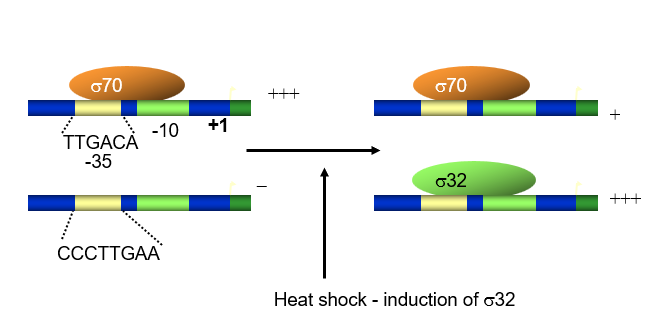1- sigma factors and catabolite repression
1/9
There's no tags or description
Looks like no tags are added yet.
Name | Mastery | Learn | Test | Matching | Spaced |
|---|
No study sessions yet.
10 Terms
what is a promoter?
defines a transcription start site and its direction

methionine is what starts transcription. what codes for this methionine?
AUG
describe the four subunits of RNA polymerase
alpha- 40kD, used for enzyme assembly, promoter recognition and activator binding. there are 2 alpha subunits
beta- 155/160 kD. there are two of these. used as catalytic centre and for termination of transcription
sigma- 20-70 kD, used for promoter recognition (like alpha), binds both to -10 gene box and -35. also used for gene switching
omega- not very important, used to maintain structure and assemble beta subunits
of the four subunits, which is the only one which makes specific contact with DNA?
sigma
how many different sigma factors are there?
5, each with different functions and DNA binding sites. the main one is sigma70, which has many general functions
when temperatures increase, how do well adapted bacteria use gene switching to cope?
they turn on several operons which encode chaperone proteins.
a sigma32 factor dissociates and begins to compete against sigma70, so that the proteins which are transcribed by the sigma70 are reduced and the cell can focus on making the chaperone proteins mostly instead

explain catabolite repression in the lac operon
PTS (phosphotransferase system) brings glucose into a cell by phosphorylating it
only when glucose levels are low, PTS instead starts activating adenylate cyclase, which is then phosphorylated by ATP to make cAMP.
high levels of glucose prevent cAMP formation (thus it is catabolite repression). glucose can control many operons i think
cAMP can then work with CRP to bind to alpha subunits of RNA polymerase on the promoter sequence
how does CRP interact with RNA polymerase?
in class I operons (like lac): contacts with a carboxy-terminal domain (CTD) of the alpha subunit.
in class II operons (like galp1): contacts with alpha CTD, alpha NTD (not so relevant) and sigma subunits. using more contact regions makes up for the fact that the CRP site overlaps with the sigma site (-35) which otherwise would have made for weak bonding
CRP provides universal control over many operons
what is it called when you have multiple CRP-polymerase contacts, like in class II?
synergism
describe the function of CRP as an architectural factor in Class III (araBAD)
there are 2 araC dimers, which interact with each other to repress araBAD
CRP binds in between these dimers, changing DNA conformation and preventing araC interaction, thus activating araBAD
active araBAD is used to make arabinose